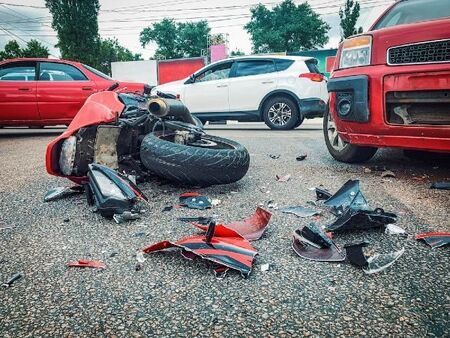
Although motorcycles make up only 3% of all registered vehicles in the United States, the National Safety Council found that motorcyclists account for 14% of all traffic fatalities.
After you’ve been injured in a motorcycle accident, it’s vital to focus on the things within your control and try to cope with moving forward. Understanding your injuries and what they mean for your future is part of that process.
For a free consultation with our Tallahassee, Florida motorcycle accident lawyers, please call (850) 601-1111 or send an online message today.
Common Motorcycle Accident Injuries
Even if an accident is not fatal, an injured person may suffer an incapacitating injury preventing them from walking, driving, or normally continuing the activities they were capable of performing before the injury occurred. According to the National Highway Traffic and Safety Administration (NHTSA), 5,579 people were killed in motorcycle accidents in 2020.
After a motorcycle accident, an injury can happen to any part of the body. The most common motorcycle injuries are lower-extremity injuries, upper-extremity injuries, and injuries to the head or thorax. Here is a list of the most common injuries associated with motorcycle accidents.
Lower-Extremity Injuries
People injured in a motorcycle accident commonly sustain leg injuries, with bone fractures being the most common type of injury.
Lower extremity injuries include:
- Fractures to the foot bones or toe amputation;
- Fractures or dislocations of the ankle, tibia, and fibula;
- Fractures of the knee;
- Tears of the ligaments or meniscus of the knee;
- Fractures of the femur, pelvis, and low back; and
- Hip dislocation.
The NHTSA found that tibia and fibula fractures were the most common leg injuries, accounting for an estimated 95% of all leg injuries. Soft tissue injuries such as injuries to the thigh arteries, veins, and nerves together accounted for only 4% of lower-extremity injuries.
Upper Extremity Injuries
While counterintuitive, upper-extremity injuries can save a rider’s life in a motorcycle accident. In a crash, the upper extremities create a “crumple zone effect,” protecting the head and neck from direct impact.
Of the common motorcycle accident injuries that occur, about 25% of motorcyclists sustain an upper extremity injury. Shoulder girdle injuries are the most common, followed by forearm fractures.
Examples of other upper extremity injuries include:
- Fractures of the humerus and hand;
- Dislocation of the shoulders, and wrists;
- Compartment syndrome—when excessive pressure builds up inside an enclosed muscle space in the body;
- Amputation;
- Arterial injuries; and
- Soft tissue injuries to the muscles, ligaments, and tendons.
While lower-extremity injuries from a motorcycle accident are more common, upper-extremity and head injuries tend to be more severe.
Head Injuries
Motorcycle brain injuries are often caused by blunt trauma to the head or a sudden deceleration when a motorcyclist’s body hits the road. This rapid deceleration causes the brain to ricochet off the inside of the skull, leading to severe brain bruising.
Although some crashes are so severe that a helmet will not prevent a head injury or death, unhelmeted motorcyclists involved in an accident are twice as likely to be hospitalized for a head injury.
Common head injuries associated with motorcycle accidents are:
- Concussion—mild traumatic brain injury;
- Traumatic brain injury (or TBI);
- Diffuse axonal injuries—damage to brain nerve fibers;
- Coup-contrecoup injuries—when an impact causes the brain to strike the inside of the skull on the opposite side of the head from the initial point of impact;
- Skull fracture—crack or break in the cranial bones;
- Open head injury—damage to the skin or exterior tissue and bone of the head; and
- Closed head injury—damage intracranially resulting in a brain bleed, swelling, or clots.
Signs of TBI include confusion, disorientation, and cognitive, physical, or behavioral changes, which may or may not be permanent.
TBIs are often life-changing and may lead to a loss of current employment, personal relationships, and financial strain. Families may struggle to provide for their loved one’s needs. When another party involved is at fault for the accident, a lawsuit could end in a large settlement if a victim has long-lasting effects from TBI or other brain-related injuries.
Thorax Injuries
The thorax, or upper trunk of the body, houses the heart, lungs, and other internal organs and is protected by the ribs.
Common injuries to the thorax include:
- Broken ribs (lacerating a spleen, kidney, or liver);
- Punctured, collapsed, or bruised lung; and
- Torn aorta (when the largest blood vessel in the body splits).
Internal injuries from a motorcycle accident result from blunt force trauma to the chest or torso. Subsequent injuries could include internal bleeding and damage to vital organs.
Hire an Attorney Today!
If you were injured in a motorcycle accident that was not your fault, you might qualify to hold the negligent driver responsible for your losses through a personal injury lawsuit.
With an AV Preeminent rating from Martindale-Hubbell® and recognition from The National Trial Lawyers, the attorneys of Nonni Homola understand what it takes to advocate for justice. To schedule a free consultation, please call us at (850) 601-1111 or send us a message.

